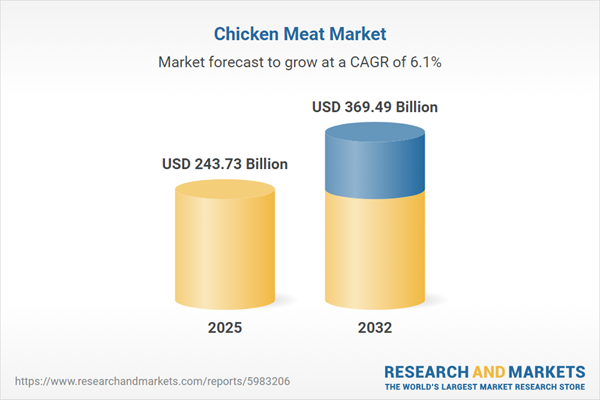Speak directly to the analyst to clarify any post sales queries you may have.
The global chicken meat market is evolving rapidly as key stakeholders respond to changing consumer demands, regulatory complexities, and a growing focus on sustainability. This report delivers pivotal insights, empowering senior executives with actionable intelligence to navigate the sector’s shifting landscape.
Market Snapshot: Chicken Meat Market Size and Growth
The Chicken Meat Market expanded from USD 229.92 billion in 2024 to USD 243.73 billion in 2025 and is projected to maintain a compound annual growth rate (CAGR) of 6.10%, rising to USD 369.49 billion by 2032.
Scope & Segmentation: Comprehensive Market Coverage
Product Type Segmentation
- Cuts: Breast, Drumstick, Thigh, Wing
- Minced Chicken: Offered for versatility in meal preparation and affordability
- Processed Chicken: Includes pre-marinated fillets and ready-to-cook items targeting convenience-driven consumers
- Whole Chicken: Favored by budget-focused households and institutions
Distribution Channels
- Foodservice: Full Service Restaurant, Institutional Catering, Quick Service Restaurant
- Retail: Convenience Store, Hypermarket, Online Retail, Supermarket
Processing Types
- Fresh: Preferred for minimal handling and quality appeal
- Frozen: Supports bulk distribution and mitigates seasonal volatility
- Further Processed: Prepared meals and value-added formats for time-pressed buyers
Poultry Breeds
- Conventional: Known for efficiency and consistent yields
- Free Range: Meets market demand for higher welfare standards
- Organic: Satisfies niche health and certification preferences
Regional Segmentation
- Americas: Including North America (United States, Canada, Mexico), and Latin America (Brazil, Argentina, Chile, Colombia, Peru)
- Europe, Middle East & Africa: Featuring key markets such as UK, Germany, UAE, and South Africa
- Asia-Pacific: China, India, Japan, Australia, South Korea, Indonesia, and more
Leading Companies
- Tyson Foods, Inc.
- JBS S.A.
- BRF S.A.
- Charoen Pokphand Foods Public Company Limited
- Marfrig Global Foods S.A.
- Pilgrim’s Pride Corporation
- Perdue Farms, Inc.
- Sanderson Farms, Inc.
- Maple Leaf Foods Inc.
- Koch Foods, Inc.
Key Takeaways for Senior Decision-Makers
- Shifting consumer preferences are driving suppliers to adopt new processing technologies and redesign value chains to emphasize transparency, traceability, and sustainability in chicken products.
- Supply chain innovations and digital integration are facilitating efficiency gains and cold chain optimization, supporting consistent product quality from farm to retail and foodservice channels.
- Industry leaders are accelerating investments in automation and alternative protein innovations, enabling greater workflow visibility and diversification beyond traditional product lines.
- The importance of regulatory compliance is rising, with a focus on animal welfare, reduced antibiotic use, and rigorous food safety. This is leading companies to pursue third-party certifications and partnerships with standards organizations.
- Emergent business models, such as direct-to-consumer channels and value-added offerings, are reshaping how products reach end users and supporting premium brand positioning.
- Sustainability imperatives—ranging from renewable energy adoption to water conservation—are being integrated across operations to support long-term competitiveness and stakeholder trust.
Tariff Impact: Strategic Adjustments in the Chicken Meat Market
The imposition of United States tariffs in 2025 has triggered significant realignments in sourcing strategies, pricing structures, and trade partnerships. Suppliers and buyers are reassessing risk, pursuing greater domestic production, and seeking alternative export channels to maintain competitiveness. While domestic producers benefit from modest demand increases, global exporters increasingly target growth opportunities in Asian and Middle Eastern markets, resulting in evolving competitive dynamics and procurement practices.
Methodology & Data Sources
This report employs a multi-pronged methodology, blending primary interviews with sector executives, structured literature review, and quantitative triangulation across production, trade, and financial data. Segment assessments leverage proprietary databases and expert validation to ensure actionable and context-aware findings.
Why This Report Matters
- Assists senior leaders in identifying growth opportunities and operational risks within the diverse chicken meat value chain.
- Enables proactive adaptation to regulatory, technology, and sustainability trends for competitive differentiation.
- Supports strategic planning with up-to-date insights into consumer, channel, and regional dynamics shaping the market’s future.
Conclusion
This report provides senior decision-makers with essential guidance for informed action in a dynamic industry. Integrated analysis, stakeholder perspectives, and actionable strategies help organizations achieve resilience, unlock innovation, and deliver value throughout the chicken meat market.
Additional Product Information:
- Purchase of this report includes 1 year online access with quarterly updates.
- This report can be updated on request. Please contact our Customer Experience team using the Ask a Question widget on our website.
Table of Contents
3. Executive Summary
4. Market Overview
7. Cumulative Impact of Artificial Intelligence 2025
Companies Mentioned
The companies profiled in this Chicken Meat market report include:- Tyson Foods, Inc.
- JBS S.A.
- BRF S.A.
- Charoen Pokphand Foods Public Company Limited
- Marfrig Global Foods S.A.
- Pilgrim’s Pride Corporation
- Perdue Farms, Inc.
- Sanderson Farms, Inc.
- Maple Leaf Foods Inc.
- Koch Foods, Inc.
Table Information
| Report Attribute | Details |
|---|---|
| No. of Pages | 187 |
| Published | October 2025 |
| Forecast Period | 2025 - 2032 |
| Estimated Market Value ( USD | $ 243.73 Billion |
| Forecasted Market Value ( USD | $ 369.49 Billion |
| Compound Annual Growth Rate | 6.1% |
| Regions Covered | Global |
| No. of Companies Mentioned | 11 |









